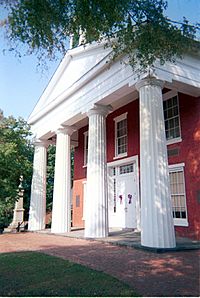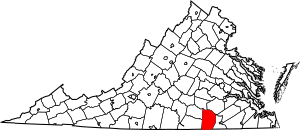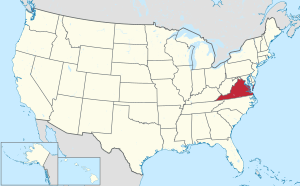Brunswick County, Virginia facts for kids
Quick facts for kids
Brunswick County
|
||
|---|---|---|

Brunswick County Courthouse in Lawrenceville
|
||
|
||

Location within the U.S. state of Virginia
|
||
 Virginia's location within the U.S. |
||
| Country | ||
| State | ||
| Founded | 1720 | |
| Named for | Duchy of Brunswick-Lunenburg | |
| Seat | Lawrenceville | |
| Largest town | Lawrenceville | |
| Area | ||
| • Total | 569 sq mi (1,470 km2) | |
| • Land | 566 sq mi (1,470 km2) | |
| • Water | 3.2 sq mi (8 km2) 0.6% | |
| Population
(2020)
|
||
| • Total | 15,849 | |
| • Density | 27.854/sq mi (10.755/km2) | |
| Time zone | UTC−5 (Eastern) | |
| • Summer (DST) | UTC−4 (EDT) | |
| Congressional district | 4th | |
Brunswick County is a county in the state of Virginia, USA. It's located on Virginia's southern border. This area is famous for being one of the places that claims to be where Brunswick stew was first made!
Brunswick County was created in 1720. It was formed from parts of Prince George, Surry, and Isle of Wight counties. The county got its name from the old Duchy of Brunswick-Lunenburg in Germany. This was the home region of the British kings from the House of Hanover. In 2020, about 15,849 people lived here. The main town and county seat is Lawrenceville.
Contents
History of Brunswick County
The first English settlers arrived in the Brunswick County area around 1714. They settled near Fort Christanna, a fort that was active for about four years. Among these early settlers were people who had to work for a certain time to pay off their travel costs. Some of these were men from Scotland who had been sent there after a rebellion in 1715. Over time, these colonists moved many of the Native American people out of the area.
One example was James Pittillo, a Scottish rebel. He finished his work period and later became a big landowner. In 1726, he received land and continued to buy more. He eventually owned over 4,000 acres (about 16 square kilometers) in the region.
Brunswick County was officially created in 1720 from Prince George County. It was named after the Duchy of Brunswick-Lunenburg in Germany, which was important to the British royal family. In 1732, the county grew bigger, taking in parts of Surry and Isle of Wight counties. Brunswick County used to stretch all the way to the Blue Ridge Mountains. But as more people moved in, new counties were formed, and Brunswick's borders became what they are today in 1745.
During the American Revolutionary War in 1780, Greensville County was formed from the eastern part of Brunswick. A small change was made to the eastern border in 1787.
Today, major roads like Interstate 85, U.S. 1, and U.S. Highway 58 run through Brunswick County. In the past, people grew tobacco here. Much of the work was done by enslaved people. As tobacco farming became less profitable, farmers started growing different crops and harvesting wood. This led to many enslaved African Americans being moved to other parts of the South where cotton was grown.
Saint Paul's College, Virginia was a school in the county connected to the Episcopal Church. It opened in 1914 but closed in 2013. Now, Brunswick County has a campus of Southside Virginia Community College. Part of the Fort Barfoot Army National Guard base is also in the county.
Geography
Brunswick County covers a total area of 569 square miles (1,474 square kilometers). Most of this is land, with only a small part (3.2 square miles or 8.3 square kilometers) being water.
Neighboring Counties
- Mecklenburg County – to the west
- Lunenburg County – to the west
- Nottoway County – to the northwest
- Dinwiddie County – to the north
- Greensville County – to the east
- Northampton County, North Carolina – to the south
Main Roads
 I-85
I-85 US 1
US 1 US 58
US 58 SR 46
SR 46 SR 136
SR 136 SR 137
SR 137 SR 378
SR 378
Population Information
| Historical population | |||
|---|---|---|---|
| Census | Pop. | %± | |
| 1790 | 12,827 | — | |
| 1800 | 16,339 | 27.4% | |
| 1810 | 15,411 | −5.7% | |
| 1820 | 16,687 | 8.3% | |
| 1830 | 15,767 | −5.5% | |
| 1840 | 14,346 | −9.0% | |
| 1850 | 13,894 | −3.2% | |
| 1860 | 14,809 | 6.6% | |
| 1870 | 13,427 | −9.3% | |
| 1880 | 16,707 | 24.4% | |
| 1890 | 17,245 | 3.2% | |
| 1900 | 18,217 | 5.6% | |
| 1910 | 19,244 | 5.6% | |
| 1920 | 21,025 | 9.3% | |
| 1930 | 20,486 | −2.6% | |
| 1940 | 19,575 | −4.4% | |
| 1950 | 20,136 | 2.9% | |
| 1960 | 17,779 | −11.7% | |
| 1970 | 16,172 | −9.0% | |
| 1980 | 15,632 | −3.3% | |
| 1990 | 15,987 | 2.3% | |
| 2000 | 18,419 | 15.2% | |
| 2010 | 17,434 | −5.3% | |
| 2020 | 15,849 | −9.1% | |
| U.S. Decennial Census 1790–1960 1900–1990 1990–2000 2010 2020 |
|||
2020 Census Details
Here's a look at the different groups of people living in Brunswick County based on the 2020 census:
| Race / Ethnicity (NH = Non-Hispanic) | Pop 2010 | Pop 2020 | % 2010 | % 2020 |
|---|---|---|---|---|
| White alone (NH) | 6,943 | 6,457 | 39.82% | 40.74% |
| Black or African American alone (NH) | 9,944 | 8,573 | 57.04% | 54.09% |
| Native American or Alaska Native alone (NH) | 35 | 23 | 0.20% | 0.15% |
| Asian alone (NH) | 47 | 42 | 0.27% | 0.27% |
| Pacific Islander alone (NH) | 4 | 5 | 0.02% | 0.03% |
| Some Other Race alone (NH) | 9 | 29 | 0.05% | 0.18% |
| Mixed Race or Multi-Racial (NH) | 154 | 333 | 0.88% | 2.10% |
| Hispanic or Latino (any race) | 298 | 387 | 1.71% | 2.44% |
| Total | 17,434 | 15,849 | 100.00% | 100.00% |
2010 Census Details
In 2010, there were 17,434 people in the county. About 57.3% were Black or African American, and 40.4% were White. A small number were Asian, Native American, or from other backgrounds. About 1.7% were Hispanic or Latino.
2000 Census Details
In 2000, Brunswick County had 18,419 people. There were 6,277 households, and 4,312 families. The average household had about 2.47 people.
The population's age breakdown was:
- 20.5% were under 18 years old.
- 9.9% were between 18 and 24.
- 30.7% were between 25 and 44.
- 24.4% were between 45 and 64.
- 14.5% were 65 years or older.
The average age was 38 years.
The median income for a household was $31,288. For a family, it was $38,354. About 16.5% of the population lived below the poverty line.
Brunswick Stew: A Local Legend
Brunswick County is most famous for being the birthplace of Brunswick stew. Local historians say the first Brunswick stew was made in 1828. It was created by an African American chef named Mr. Jimmy Matthews, who some locals called "Uncle."
The story goes that Dr. Creed Haskins, a member of the Virginia State Legislature, went on a hunting trip. While the group hunted, Mr. Matthews, who was Dr. Haskin's cook, hunted squirrels for dinner. Mr. Matthews slowly cooked the squirrels with butter, onions, old bread, and spices in a big iron pot. When the hunters came back, they weren't sure about this new, thick dish. But after one taste, they loved it and wanted more!
Since then, many "stew masters" have made Brunswick stew. It's often made in the fall during harvest time. People make huge batches for church events, fundraisers, family get-togethers, and political meetings. Each cook adds their own twist to Jimmy Matthews's original recipe. For example, chicken is often used instead of squirrel, and vegetables are added.
In 1987, Brunswick County decided to use Brunswick stew to help its economy grow. On February 22, 1988, they held a "Brunswick Stew-Fest" at the State Capitol in Richmond. This celebrated the Virginia General Assembly officially declaring Brunswick County, Virginia, as "The Original Home of Brunswick Stew." This led to a friendly competition, sometimes called "The Stew Wars," with Brunswick, Georgia, which also claims to be the stew's origin.
One traditional recipe, which takes 6 to 7 hours to cook, was renamed "Brunswick Proclamation Stew" for the event. Stew masters say a good Brunswick stew must be cooked slowly until "the stirring paddle stands up straight in the stew." When the paddle stood, the stew was served to lawmakers and hundreds of Virginians who came to "Get a Taste of Brunswick."
With help from the Fearnow Brothers company, the county even got its own stew label approved by the U.S. Department of Agriculture (USDA). This company also makes small amounts of canned Brunswick stew for the Chamber of Commerce. These cans say "Virginia's Own – 1828-Brunswick County Stew."
The stew, along with information about the county, was sent to businesses to encourage them to move there. The main idea of the campaign was: "Since 1828 when Ol’ Jimmy Matthews created Brunswick stew, we’ve been doing things a special way. A little slow, but right."
Communities in Brunswick County
Towns
- Alberta
- Brodnax (partially in Brunswick County)
- Lawrenceville (the county seat)
Census-Designated Places
Unincorporated Communities
Famous People from Brunswick County
- Aaron Brown (1795–1859), a Governor of Tennessee
- Albertis Harrison (1907–1995), a Governor of Virginia
- George Jackson (1850–1900), an American politician
- Goronwy Owen (1723-1769), a Welsh-American poet and plantation owner
- Hon. Cleo Powell (1957- ), a Justice on the Supreme Court of Virginia
- Peter Starke (1813–1888), a politician and Confederate general
- Bryant Stith (1970- ), an NBA basketball player
Images for kids
See also
 In Spanish: Condado de Brunswick (Virginia) para niños
In Spanish: Condado de Brunswick (Virginia) para niños




